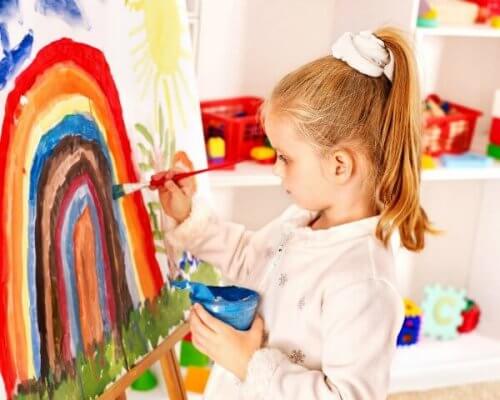How to Teach Children About the Importance of Art

Art is related to the communication of a person’s feelings, ideas, emotions and vision of the world through images, sounds, language or the body itself. It’s fundamental to teach children about the importance of art from an early age. But how can we do this? And what are the benefits?
Art improves children’s skills
In itself, art is an activity that humans perform with the purpose of transmitting or experiencing certain sensations. This is reflected through different trends or styles.
The world is full of small joys: art consists of knowing how to distinguish them.
–Li Tai-Po–
Contrary to popular belief, art is not an issue that should be taken lightly, since it constitutes a fundamental element in children’s education. In fact, teaching the importance of art opens the way to teaching values.
How to teach children the importance of art
Teaching art is nothing new. The ancient Greeks divided the arts into higher and lower forms. The higher arts encompassed those that put into practice the senses of sight and hearing. While the lower arts referenced the senses of smell, taste and touch.
Below we’ll explain some methods and techniques to bring your child closer to the world of art. However, there are many other alternatives that you can also do together.
Music
You should look for a quiet place where the child can listen to music and learn the meaning of the lyrics. Children can also write the lyrics to a song or compose a melody to express their feelings.

Sculpture
You should also look for a peaceful place for this. Using a vase or any other type of sculpture, you can decide with your child what you want to make. Then, use clay to teach him or how her how to mold and create it.
Painting
Paintings cannot be overlooked when teaching children about the importance of art. You can choose a painting and analyze the feeling that the artist intends to transmit through a landscape, facial expression, object or colors. Of course, it’s also important to let children make their own drawings and paintings, allowing them to reflect on what they feel.
Architecture
Architecture also plays a fundamental role in teaching the importance of art. In this case, you and your child can imagine what his or her “ideal house” would be like, and then translate it into a drawing.
The benefits of teaching children the importance of art
According to various studies conducted with American high school students, those who had a close relationship with art obtained higher grades and presented fewer risks of school failure.
On the other hand, another study was conducted with children between the ages of 5 and 7 who were behind in almost all subjects, compared to their classmates. After seven months of adding an additional hour of arts and music for these children, the results showed that they reached the same level of reading as their classmates and even surpassed them in mathematics.
But that’s not all. Teaching children the importance of art generates many other benefits.
- Art teaches children to think creatively and helps them solve problems
- Promotes their self-esteem
- Helps them share and reflect on themselves and the world around them
- Promotes teamwork
- Improves hand-eye coordination
- Facilitates the development of language
Art is a means to overcome prejudices
Children are exposed to different possibilities and freedoms. In this sense, art constitutes an element or means to overcome barriers and prejudices. In addition, art puts the child in contact with the distant past.

Art stimulates both sides of the brain
Art stimulates both sides of the brain, and several studies suggest that children who are exposed to art get better grades in mathematics and read better. Another beneficial aspect is that it teaches children to use their senses in learning. We must bear in mind that, through art, children are able to pay more attention to the physical space around them.
Painting, playing a musical instrument, drawing and singing are all activities that contribute to the educational, emotional and biological development of every child.
But the benefits of art go even further, since it even satisfies a spiritual need. Through these activities, children can explore their surrounding environment, becoming aware of themselves and other people.
It’s very important that children are able to express themselves and feel comfortable doing so. Parents must always pay attention to their children’s opinions and feelings. Art is no exception. By means of a painting, a sculpture, or the lyrics of a song, they may be revealing something very personal.
All cited sources were thoroughly reviewed by our team to ensure their quality, reliability, currency, and validity. The bibliography of this article was considered reliable and of academic or scientific accuracy.
- Cándano, S. (2013). La pintura beneficiosa para el desarrollo de los niños. http://www.ampaikasbide.com/downloads/pintura/Desarrollo%20y%20aprendizaje.pdf
- Lopez, Z. V. (2011). La pintura como agente motivador para desarrollar la psicomotricidad en niños y niñas de primer año de educacion basica de la escuela fiscal 11 de noviembre de la ciudad de latacunga provincia de cotopaxi. latacunga provincia de cotopaxi.
- Salazar, R. (2011). La importancia de la creatividad y el arte.
- Vélez Luzardo, E. M. (2016). La pintura medio esencial para el desarrollo creativo en los niños de 2do. año de educación básica de la unidad educativa Clara Bruno de Piana (Bachelor’s thesis, Universidad de Guayaquil. Facultad de Comunicación Social. Carrera de Ingienería en Diseño Gráfico.). http://repositorio.ug.edu.ec/bitstream/redug/9729/1/TESIS%20EMAVELU%202016.pdf
- Villavicencio, Y. (2007). el desarrollo de la creatividad e imaginación a través de las técnicas grafoplásticas en la educación preescolar del liceo naval de manta en el periodo 2006-2007. Manta – Manabí – Ecuador.
This text is provided for informational purposes only and does not replace consultation with a professional. If in doubt, consult your specialist.
